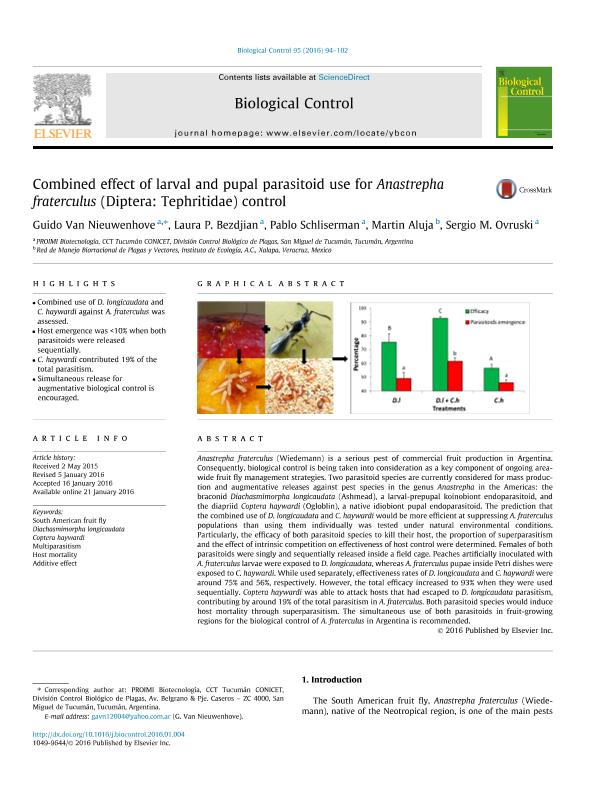Artículo
Combined effect of larval and pupal parasitoid use for Anastrepha fraterculus (Diptera: Tephritidae) control
Van Nieuwenhove, Guido Alejandro ; Bezdjian, Laura Patricia
; Bezdjian, Laura Patricia ; Schliserman, Pablo
; Schliserman, Pablo ; Aluja, Martin; Ovruski Alderete, Sergio Marcelo
; Aluja, Martin; Ovruski Alderete, Sergio Marcelo
 ; Bezdjian, Laura Patricia
; Bezdjian, Laura Patricia ; Schliserman, Pablo
; Schliserman, Pablo ; Aluja, Martin; Ovruski Alderete, Sergio Marcelo
; Aluja, Martin; Ovruski Alderete, Sergio Marcelo
Fecha de publicación:
04/2016
Editorial:
Academic Press Inc Elsevier Science
Revista:
Biological Control
ISSN:
1049-9644
Idioma:
Inglés
Tipo de recurso:
Artículo publicado
Clasificación temática:
Resumen
Anastrepha fraterculus (Wiedemann) is a serious pest of commercial fruit production in Argentina. Consequently, biological control is being taken into consideration as a key component of ongoing area-wide fruit fly management strategies. Two parasitoid species are currently considered for mass production and augmentative releases against pest species in the genus Anastrepha in the Americas: the braconid Diachasmimorpha longicaudata (Ashmead), a larval-prepupal koinobiont endoparasitoid, and the diapriid Coptera haywardi (Ogloblin), a native idiobiont pupal endoparasitoid. The prediction that the combined use of D. longicaudata and C. haywardi would be more efficient at suppressing A. fraterculus populations than using them individually was tested under natural environmental conditions. Particularly, the efficacy of both parasitoid species to kill their host, the proportion of superparasitism and the effect of intrinsic competition on effectiveness of host control were determined. Females of both parasitoids were singly and sequentially released inside a field cage. Peaches artificially inoculated with A. fraterculus larvae were exposed to D. longicaudata, whereas A. fraterculus pupae inside Petri dishes were exposed to C. haywardi. While used separately, effectiveness rates of D. longicaudata and C. haywardi were around 75% and 56%, respectively. However, the total efficacy increased to 93% when they were used sequentially. Coptera haywardi was able to attack hosts that had escaped to D. longicaudata parasitism, contributing by around 19% of the total parasitism in A. fraterculus. Both parasitoid species would induce host mortality through superparasitism. The simultaneous use of both parasitoids in fruit-growing regions for the biological control of A. fraterculus in Argentina is recommended.
Archivos asociados
Licencia
Identificadores
Colecciones
Articulos(PROIMI)
Articulos de PLANTA PILOTO DE PROC.IND.MICROBIOLOGICOS (I)
Articulos de PLANTA PILOTO DE PROC.IND.MICROBIOLOGICOS (I)
Citación
Van Nieuwenhove, Guido Alejandro; Bezdjian, Laura Patricia; Schliserman, Pablo; Aluja, Martin; Ovruski Alderete, Sergio Marcelo; Combined effect of larval and pupal parasitoid use for Anastrepha fraterculus (Diptera: Tephritidae) control; Academic Press Inc Elsevier Science; Biological Control; 95; 4-2016; 94-102
Compartir
Altmétricas



